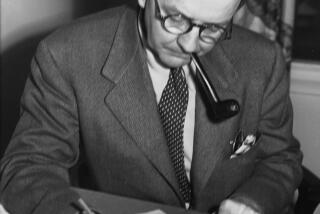M.H. Abrams dies at 102; editor of ‘Norton Anthology’
M.H. Abrams, an esteemed critic, teacher and tastemaker who helped shape the modern literary canon as founding editor of “The Norton Anthology of English Literature” and joined the elite himself by writing one of the 20th century’s most acclaimed works of criticism, has died. He was 102.
Abrams’ death was confirmed Wednesday by Cornell University. According to the university’s website, Abrams died Tuesday at a retirement community in Ithaca, N.Y. No cause of death was given.
While at Cornell in the 1950s, Abrams was asked by publisher W.W. Norton to lead a team of editors compiling excerpts of vital English works. The first edition of the “Norton Anthology” came out in 1962 and was an immediate success. Abrams stayed on through seven editions, into his 80s, as the book became required reading — or perusing — for millions of college students.
Abrams also wrote several books, including the 1953 publication “The Mirror and the Lamp,” a groundbreaking work of literary theory that celebrated Byron, Keats and other British Romantic poets and popularized a field of study that emphasized how authors’ lives and feelings influenced their work.
“The Mirror and the Lamp” was ranked No. 25 on a Modern Library list of the greatest English-language nonfiction books of the 20th century.
In the years before “The Mirror and the Lamp,” the Romantics had been effectively denigrated by T.S. Eliot, who found Byron to have a “disorderly mind, and an uninteresting one” and believed Keats and Shelley “not nearly such great poets as they are supposed to be.” He valued reason and restraint, stating that a poem’s meaning should be clear.
But Abrams countered that the Romantics changed and enriched the history of poetry by freeing the emotions and imagination. The Romantics broke from the ideal of capturing the real world (a mirror) and instead composed “lamps,” illuminating the poet’s personal vision.
A son of Russian Jewish immigrants, Meyer Howard Abrams was born July 23, 1912, and raised in Long Branch, N.J. As a child, he spoke Yiddish until the age of 5 and loved reading so much that he would borrow up to three books at a time from the library and then return the next day for more.
He was a scholarship student at Harvard University — and one of the few Jews then permitted at Harvard — and later won a scholarship to Cambridge University. He joined the Cornell faculty in 1945 and instructed such future literary stars as novelist Thomas Pynchon (who submitted a term paper so accomplished that Abrams suspected — wrongly — it was plagiarized) and the critic Harold Bloom.
Known fondly to Bloom and others as “Mike” Abrams, he modeled his work for Norton on his literature course. Abrams and his colleagues “believed that to understand literature you had to understand its place in history and culture.”
Abrams experimented with content and form. When he was an undergraduate at Harvard, anthologies were grim, square volumes with double-column printing on each page. Abrams innovated with single columns and the kind of fine, thin paper used for Bibles, making the anthology portable. The preface of the first edition promised a volume that “can not only be carried everywhere, but read anywhere, in one’s own private room, in the classroom, or under a tree.”
The anthology was conceived when the canon was overwhelmingly white and male, but Abrams and his fellow editors opened up over the following decades, including women and “post-colonial” authors such as Salman Rushdie, Chinua Achebe and V.S. Naipaul. Norton, meanwhile, issued numerous separate anthologies that included volumes on African American writers, Latinos and nonfiction authors.
He received the National Humanities Medal from President Obama in July.
Abrams married Ruth Gaynes in 1937. He is survived by two daughters, two grandchildren and a great-grandson.
Hillel Italie writes for the Associated Press.
More to Read
Start your day right
Sign up for Essential California for the L.A. Times biggest news, features and recommendations in your inbox six days a week.
You may occasionally receive promotional content from the Los Angeles Times.






